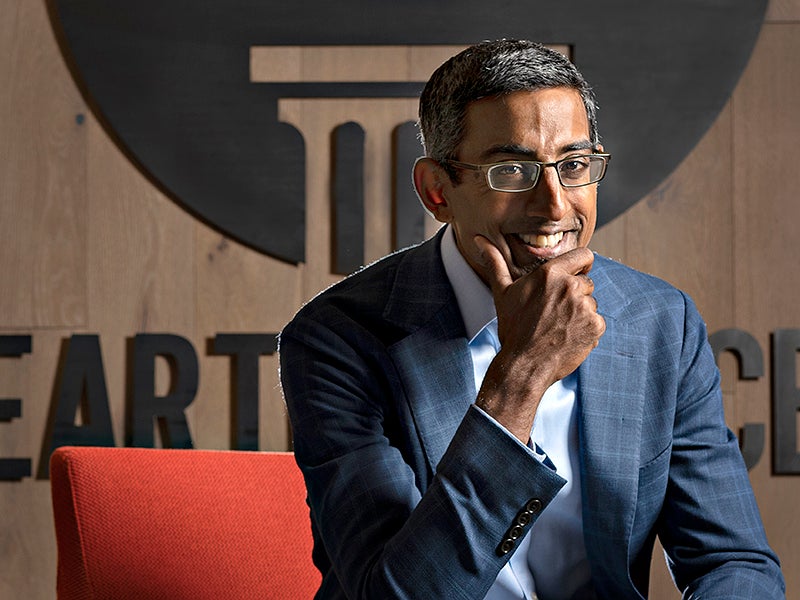How an Environmental Lawyer Stays Motivated to Fight the Climate Crisis
Sambhav Sankar, Earthjustice’s senior VP of programs, shares his perspective on what environmental litigation can achieve.

This page was published 4 years ago. Find the latest on Earthjustice’s work.
Before coming to Earthjustice, you were a lawyer for the Department of Justice (DOJ). How would you compare these experiences?
There, I was a knife fighter. Here, I’m a knife fighter with a mission.
At DOJ, your clients are government agencies. You don’t get to pick and choose which of their decisions you defend. Some you agree with, some you don’t. You have to tell yourself you’re part of a larger enterprise of environmental protection that requires a strong government to enforce those laws.
At Earthjustice, our clients are real people. We have a smaller stick, but we choose where we swing it — and I want to win every single case we handle at Earthjustice.
What are some common misunderstandings about environmental litigation?
It’s not like “Law & Order.” We rarely argue before juries or have dramatic moments where someone changes their testimony on the stand. Environmental law is super nerdy. You have to read a lot of dense regulations and understand the science. The magic comes when you transform that technical stuff into a case. When you’re litigating, it’s never about the minutiae. It’s always about the story. Every decision-maker is moved by wanting to do the right thing. We write the story with the judge as the hero.
How has the public’s perception of environmental law shifted over your career?
Fifty years ago, most people perceived environmental law as protecting beautiful wild places or preventing pollution in the abstract. Nobody connected it to people being harmed.
Now, environmental protection is much more people-centric. It’s increasingly apparent to everyone that our way of living is unsustainable at a planetary and a social level. Most of the costs have been put on the backs of a subset of our population: historically disenfranchised races; people without money; people of the global south.
While the good times have been rolling for some, they haven’t been for everyone, and the planet is giving all of us a wakeup call. The practice hasn’t fundamentally changed, but the aims and implications of our lawsuits are much bigger.
Do you believe that judges appreciate the prevalence of environmental justice issues?
Yes. Judges are human beings. They read the newspaper. Their kids go to school. Good judges recognize that our society is set up in a way that allows and encourages us to put the burden on people who are not able to immediately defend themselves.
Most judges are looking to do the right thing, and we try to show it to them. At the end of a brief, you want a judge to say, “Sounds great. Where do I sign?”
What’s an example of how Earthjustice is using the law in a creative way?
Taking on utility companies is one of the most audacious strategies the environmental community ever came up with. We realized that intervening in the state proceedings where regulators decide how much utilities can charge ratepayers, and what for, could be an incredibly powerful way to drive environmental change. It’s a way for regular people to hold some of the biggest, most polluting industries accountable.
When we first started doing those cases, the utility companies were totally confused. No one had ever pushed back on them in these proceedings before. But we keep winning by making the same basic argument: The law says you have to regulate these companies in the public interest. Let’s make sure you know what that is.
What environmental law do you wish was on the books?
So, we have the National Environmental Policy Act (NEPA). It says the government must analyze and consider the environmental impacts of a project. Earthjustice uses NEPA all the time to challenge permits and approvals for industry projects that would harm the environment. The addendum that Congress hasn’t written, and would make all the difference, is the government’s actions must leave the environment in better condition than it was before. Right now, agencies only need to consider other alternatives. Imagine if the law said they had to choose the best one for the environment.
Fighting the climate crisis can get pretty bleak. What keeps you motivated?
One is the energy and commitment of young climate activists, like Varshini Prakash and Greta Thunberg. I feel so thankful that they’re here. They give me hope.
The other thing is nature itself. No matter how long I forget to water the garden, or how cold the winter was, the sprouts keep trying to come up and the leaves keep trying to come back. Despite all that’s happened to life over the millennia — like an asteroid — the Earth keeps generating beauty and marvels, and will continue to. They may not be the ones I enjoyed as a kid, and the world may be a darker place for a while, but it’ll come back.
Earthjustice’s Washington, D.C., office works at the federal level to prevent air and water pollution, combat climate change, and protect natural areas. We also work with communities in the Mid-Atlantic region and elsewhere to address severe local environmental health problems, including exposures to dangerous air contaminants in toxic hot spots, sewage backups and overflows, chemical disasters, and contamination of drinking water. The D.C. office has been in operation since 1978.